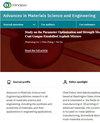Preparation and Characterization of Protein-Based Hydrogel: Cottonseed Protein Grafted with 2-Acrylamido-2-Methylpropanesulfonic Acid (AMPS)
4区 材料科学
Q2 Engineering
引用次数: 0
Abstract
Using synthetic polymers in the production of superabsorbent polymers offers significant advantages such as low cost, extended service life, and a high water absorption rate. However, concerns about the environmental impact and potential adverse effects on plant growth arise from the degradation products of these polymers after disposal. In addition, handling these polymers can cause rashes, irritations, and even toxic shock syndrome. To overcome these issues, researchers are exploring the synthesis of superabsorbent polymers from natural sources. Cottonseed protein is identified as a potential natural polymer for the synthesis of natural superabsorbent polymers. Notably, there is no existing research on hydrogel synthesis using cottonseed protein and 2-acrylamido-2-methylpropanesulfonic acid (AMPS). This study addresses this gap by focusing on modifying cottonseed protein (CSP) through graft copolymerization, utilizing the partially neutralized form of 2-acrylamido-2-methylpropanesulfonic acid (AMPS) in a water-based solution. N,N-methylene bisacrylamide serves as the crosslinking agent, while potassium persulfate (PPS) and sodium bisulfite (SBS) function as redox initiators. The optimization of hydrogel synthesis conditions was achieved using Design Expert-11 software, adjusting the AMPS to CSP ratio. The research reveals that the hydrogel reaches its maximum swelling capacity (195.7 g/g) with 0.03 g of MBA, 0.01 g of PPS, 0.01 g of SBS, and a 1wt% AMPS to CSP ratio. Swelling properties were assessed under diverse pH conditions, and the study delved into swelling kinetics (both pseudo-first-order model and pseudo-second-order model) and performance under different loads. Grafting evidence was validated through FTIR analysis. The maximum water uptake was obtained when there was no load, and the pH value was around neutral (7). In conclusion, the results indicate that the developed hydrogel holds a promise for applications in water retention, reducing water loss, and serving as an environment-friendly, biocompatible superabsorbent polymer so we can use such hydrogel in biomedical applications.蛋白基水凝胶的制备与表征:2-丙烯酰胺基-2-甲基丙磺酸(AMPS)接枝棉籽蛋白
使用合成聚合物生产超吸水性聚合物具有成本低、使用寿命长和吸水率高等显著优势。然而,这些聚合物在废弃后的降解产物会对环境造成影响,并对植物生长产生潜在的不利影响。此外,处理这些聚合物可能会引起皮疹、刺激甚至中毒性休克综合症。为了克服这些问题,研究人员正在探索从天然来源合成超吸水性聚合物。棉籽蛋白被认为是合成天然超吸收聚合物的潜在天然聚合物。值得注意的是,目前还没有利用棉籽蛋白和 2-丙烯酰胺基-2-甲基丙磺酸(AMPS)合成水凝胶的研究。本研究利用水基溶液中部分中和形式的 2-丙烯酰胺基-2-甲基丙磺酸 (AMPS),通过接枝共聚改性棉籽蛋白 (CSP),填补了这一空白。N,N-亚甲基双丙烯酰胺作为交联剂,过硫酸钾(PPS)和亚硫酸氢钠(SBS)作为氧化还原引发剂。利用 Design Expert-11 软件优化了水凝胶的合成条件,调整了 AMPS 与 CSP 的比例。研究表明,当 MBA 为 0.03 克、PPS 为 0.01 克、SBS 为 0.01 克、AMPS 与 CSP 的比例为 1wt% 时,水凝胶的溶胀能力达到最大值(195.7 克/克)。在不同的 pH 值条件下对溶胀特性进行了评估,并深入研究了溶胀动力学(伪一阶模型和伪二阶模型)以及不同负载下的性能。傅立叶变换红外分析验证了接枝证据。在无负载和 pH 值为中性(7)左右时,吸水率最大。总之,研究结果表明,所开发的水凝胶有望用于保水、减少水分流失,并可作为一种环境友好、生物兼容的超吸收聚合物,因此我们可以将这种水凝胶应用于生物医学领域。
本文章由计算机程序翻译,如有差异,请以英文原文为准。
求助全文
约1分钟内获得全文
求助全文
来源期刊

Advances in Materials Science and Engineering
Materials Science-General Materials Science
CiteScore
3.30
自引率
0.00%
发文量
0
审稿时长
4-8 weeks
期刊介绍:
Advances in Materials Science and Engineering is a broad scope journal that publishes articles in all areas of materials science and engineering including, but not limited to:
-Chemistry and fundamental properties of matter
-Material synthesis, fabrication, manufacture, and processing
-Magnetic, electrical, thermal, and optical properties of materials
-Strength, durability, and mechanical behaviour of materials
-Consideration of materials in structural design, modelling, and engineering
-Green and renewable materials, and consideration of materials’ life cycles
-Materials in specialist applications (such as medicine, energy, aerospace, and nanotechnology)
 求助内容:
求助内容: 应助结果提醒方式:
应助结果提醒方式:


